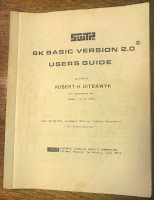 |
| Percom CIS-30+. Note that the handles of two switches have broken off. |
Around December 1977, I purchased the Percom CIS-30+ cassette tape interface. These interfaces allowed one to store and load programs on audio cassette tapes.
The CIS-30+ had major advantage over the SWTPc AC-30 cassette tape interface. Like the AC-30, the CIS-30+ supported the 300 bps Kansas City standard, but it could also record and decode at 600 and 1200 bps. This allowed programs to be stored and loaded two to four times faster.
 |
| Insides of the CIS-30+. |
Originally, the CIS-30+ sat on top of the SWTPc 6800 Computer System. At some point, before I moved to Atlanta, I removed the board from the small aluminum case, and mounted it on the front panel of the SWTPc 6800 Computer System, in a space right above the power switches. This made the whole unit more compact, and reduced the number of cables that had to be dealt with.
I've since removed the cassette interface, and the holes that remain in the computer font panel.
The first program loaded was Rob Uterwick's Tiny Basic, which required 4 KB of memory. That was perfect for my machine, as it left 8 KB of space for programs.
Tiny Basic was distributed uniquely. The May 1977 issue of Interface Age contained a thin plastic record with Tiny Basic in Kansas City standard format. I jigged up a circuit so I could play the record on my family stereo and record it on a cassette tape. It took several tries to get the levels right, so the recording was readable. The magazine also had a hex dump of the program, so I verified that everything loaded correctly.
Tiny Basic was fun, but very limited - no string variables or functions. In the spring of 1978, I purchased SWTPc's 8K BASIC and the 6800 Co-Res Assembler / Editor. |
| Rob Uterwyk's 8K BASIC Manual. |
 |
| 6800 Co-Res Manual. |
One of the magazines published a Fantasy Adventure text game in BASIC, and I managed to get it running on my computer. At school we had a "Fantasy and Renaissance Fair", and my computer was featured running this game as one of the exhibits.
Setting up the computer to run this game was an involved process. First, you had to load the BASIC interpreter. The first part of the 8K BASIC tape had a binary loader program (which was twice as fast as the Motorola S1 format). With that program loaded and executed, you would load BASIC. The second step, after BASIC was running, one loaded the game from a different cassette tape. Then one could execute the game. All of this was done at 1200 bps speed, and the process took nearly 30 minutes.
Someone managed to kick the power button on the computer in the middle of playing, turning it off. I spent the next 30 minutes of the festival re-starting the game....




